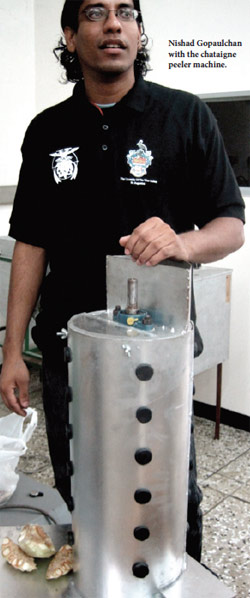

 The Chataigne fruit is well known in parts of the Caribbean, notably Trinidad and Guyana, as a delicacy served in a coconut curry sauce at special occasions, such as weddings and at Divali. The Chataigne fruit is well known in parts of the Caribbean, notably Trinidad and Guyana, as a delicacy served in a coconut curry sauce at special occasions, such as weddings and at Divali.
A close relative of the breadfruit (Artocarpus altilis), the chataigne (Artocarpus camansi) contains twice the protein, and its seeds are low in fat compared with nuts such as the almond, brazil, and macadamia.
Known in the region as the bread nut or katahar (Guyana) it is prized when ripened for the seeds, and when mature, but not ripe, it is prepared in delicately flavoured curries.
To do this, the thick, spiky skin must be removed, and the flesh shredded apart by hand after the seeds are painstakingly removed. Served with roti (paratha) along with other vegetables, it is a popular dish at weddings and other functions.
While the demand for curried chataigne has been growing, the task of peeling and preparing the fruit is so labour intensive that it makes it almost prohibitive.
A typical wedding might require 300 chataigne fruits for a side dish, and this would take about 12 man-days for preparation, i.e. peeling, shredding and then preparing the seeds before cooking. No wonder it has remained such an occasional delicacy!
That might soon be a thing of the past.
Nishad Gopaulchan, a final year Mechanical Engineering student at The UWI, has designed and built a simple machine that can prepare 100 chataigne fruits in an hour.
DEVELOPING THE MACHINE
Various methods for separating the seeds from the fibrous inner core of the fruit were considered and these included friction, brushing and impact, however the one that showed the best potential was impact.
Initial trials with steel rods impacting on the inner core of the fruit, left bruises or marks of injury on the final product. Although this could be minimized and managed, it showed up as brown to black marks on the product when kept refrigerated for awhile.
Replacing the steel rod beaters with a steady rubber one, minimized, if not eliminated, the problem of impact injury on the finished product.
Placing the rotating and stationary rubber fingers was a critical factor in the design, as the spacing must be appropriate to allow the flow of the separated fiber and seeds through the machine without clogging and “sticking” the machine.
The machine is powered by a single phase 110 Volt motor; hence it can be plugged into any domestic household electric supply.
The machine is ergonomically designed; the hopper is at the top and can be easily reached by the average adult while the lower chute allows enough height to place a receptacle to collect the finished product. There are no sharp edges or projecting bolts that could create risks for injury to users of the machine.
COMMERCIAL POTENTIAL FOR THE MACHINE
The machine was on display at both the recently concluded Sci-technofest, run by NIHERST and the Open Day at the Faculty of Engineering; without quoting a price for the machine, more than 100 persons have indicated an interest in having one of these machines.
Among those who have expressed interest, caterers were the largest group. At the Faculty of Engineering at UWI, we see this as a wonderful opportunity to expand the consumption of local cuisine, with its attendant backward linkage with agriculture, while simultaneously creating the opportunity to commercialize our homegrown mechanical, machine-building skills.
The project has a high potential for success both locally and internationally.
–Rodney Harnarine is a development engineer at the Department of Mechanical and Manufacturing Engineering, at The UWI, St. Augustine. He supervised the construction of Nishad Gopaulchan’s Chataigne Peeler.
By Rodney Harnarine
|





